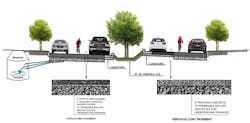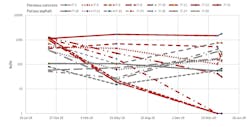In the City of Spokane, WA, along the northern border of the Gonzaga University campus and just a few blocks from the Spokane River, lies Sharp Avenue, a minor arterial street located within the City’s separated stormwater system. The street sits above part of the Spokane Valley-Rathdrum Prairie (SVRP) Aquifer, the sole source drinking water aquifer for around a million people in Washington and Idaho. Stormwater runoff within the City ultimately recharges the SVRP aquifer via various infiltration pathways or discharges directly to the Spokane River, which is listed as impaired for metals and PCBs and has a Total Maximum Daily Load (TMDL) limit for dissolved oxygen. In 2014, the City implemented a multipronged approach to improving water quality in the Spokane River, including the implementation of creative solutions for the management of runoff to include infiltration. Because there is a drinking water aquifer underlying much of the City, adequate water quality treatment is crucial prior to any infiltration approaches used to manage stormwater.
In the last few years, the City of Spokane has focused on an integrated approach to its infrastructure projects, working to address multiple concerns in a single project. Sharp Avenues’ pavement had been in very poor shape, and it contrasted against the manicured lawns and many young pedestrians of the university, and it was perfect for an overhaul focused on stormwater management that would provide valuable information on the effectiveness of permeable pavement treatment of stormwater. Using an integrated approach, the project also enhanced pedestrian safety through the addition of bump-outs at intersections, added a center swale to manage stormwater if the permeable pavements were insufficient, and the area was beautified with the addition of landscaping.
Spokane kicked off the project to evaluate permeable pavements in a semi-arid environment that has hot summers with long antecedent periods between storm events, and cold winters that often have multiple freeze-thaw cycles. The project area is approximately four acres of impervious pavements that constitute a section of Sharp Avenue, which has an average daily traffic count of up to 7,500 vehicles. The permeable pavements were constructed within the vehicular traveled way on Sharp Avenue, and consist of several different cross-sections with varying layouts.
Project Construction
The construction goal was to install different layouts with the pavements to capture performance information of each material. The City’s design engineers developed design and cost documents for several layouts of differing pavements for cross-sections that varied by material, layout widths, and slope direction by location. The final design was of adjacent areas that were either full street width, vehicle lane only, and/or bike and parking lanes, each with differing slope directions and comprised of either porous hot mix asphalt (HMA), pervious concrete, or standard impervious asphalt.
- Pervious concrete in full lane width (25 feet wide) on the north side of Sharp Ave from Lidgerwood Street to Astor Street.
- Pervious concrete in parking and bike lane (14 feet wide) with 11 feet of run-on on the south side of Sharp Ave from Lidgerwood Street to Astor Street. Underdrain installed under the pervious concrete parking and bike lane.
- Pervious concrete in full intersection of Sharp Ave at Astor Street.
- Porous hot mix asphalt in full lane width (25 feet wide) on both sides of the median of Sharp Ave from Addison Street to Dakota Street. Underdrain installed under the south lane from Astor to Addison.
- Porous hot mix asphalt in full intersection at Sharp Ave and Standard Street.
Stormwater Monitoring
Stormwater monitoring is being performed to determine the pollutant removal efficiency of the pavements for typical roadway contaminants prior to infiltration into native soils that overlie the SVRP Aquifer. Equipment for three sample stations (one background and two for pavement underdrain effluents) were installed in manholes and connected via piping to each of the sample sources. The background station captures untreated runoff from the west end of the project area, and the pavement underdrain effluent stations capture infiltrated runoff through pervious concrete and porous asphalt pavement sections.
Infiltration rate tests were performed over time at 15 locations on both pervious concrete and porous asphalt. The infiltration rates for the porous asphalt ranged from 52 to 691 inches per hour initially, and the rates for pervious concrete initially ranged from 19 to 1762, each showing significant heterogeneity. Year one data indicates that the porous asphalt infiltration rate is consistently similar over time, whereas the pervious concrete appears to show signs of diminishing infiltration rates with some locations near-zero infiltration. It is unclear if the lower infiltration rates are an artifact of plugging or deterioration of the pervious concrete. The City currently performs street sweeping with a Tymco 500x regenerative air system vacuum sweeper twice a year to clean the surface of the pavements, but a more rigorous cleaning method that uses a maintenance vehicle specific to permeable pavements may be required to address the diminishing rates of infiltration.
Durability
The Pavement Condition Index (PCI) is a score from 0-100, where 100 would be a road surface in perfect condition with no wear. The City’s Streets Department has applied a PCI score to Sharp Avenue annually to track the durability. As of Fall 2020, the porous asphalt sections have a PCI score of 82 while the remainder of the sections, including the pervious concrete, have a PCI score of 98 or better. The wear that has affected the PCI score occurred within the first year, and there was no change in the scores between the last two surveys. Since the wear was not significant and the scores remained the same from the last survey, the City is not overly concerned with the PCI score. PCI surveys will continue indefinitely on Sharp Avenue as it is integrated into the citywide PCI scoring program.
Learnings to Share
There were several lessons learned during the construction phase of this project. First and foremost, selecting an appropriate location is critical. It was determined early that the native soils in this area of the City were favorable for infiltration and treatment, which is clearly critical for the final disposal of stormwater. In addition, having a single property owner/stakeholder (i.e. Gonzaga University) with multiple entrance/exit points and few dry utility connections simplified construction immensely. Specifically, the ability to keep vehicles and equipment off of the permeable pavements during construction and to minimize the in and out traffic as much as possible were paramount to a successful install on schedule.
Since completion of construction, City teams have worked to evaluate the effectiveness of the permeable pavements on Sharp Avenue and use its lessons to plan future green infrastructure projects. The end goal is to minimize stormwater discharges to the river and provide long-term value to the community. The positive status of the project to date is due to City staff communicating effectively across departments, and being committed to delivering a high-quality product. For example, the designers identified construction materials and methods that would ensure the project was constructible, that the pavement layout capitalized on the best use of permeable materials, and identified the best locations for sampling stations. The Street’s Department has adopted a non-standard maintenance approach for leaf removal to avoid clogging the pavements and use a rubber-bit snowplow to prevent damaging them. The sewer maintenance crew and inspectors have stepped out of their comfort zone to learn new skill sets to collect data and perform inspections. The wastewater management sampling team designed and installed the sample collection train, and have added Sharp Avenue to their routine list of sites to prepare for when eagerly chasing storms. It takes a village.
The City of Spokane will continue to monitor the permeable pavements for an additional four years and will report the observations to the Washington State Department of Ecology in an Effectiveness Study report. Data is also available to the public on Ecology’s Environmental Information Management System website at www.apps.ecology.wa.gov/eim/search/default.aspx.
Mark Papich, PE, is a senior engineer in the City of Spokane’s Integrated Capital Management Department and is responsible for capital project scoping, funding, and programming the City’s utility projects. Papich has designed and programmed water, sewer, and stormwater capital projects, following projects from inception to completion of construction. James "Trey" Geroge III is an environmental analyst for the City of Spokane where he is responsible for ensuring that the City meets the conditions of its’ Phase II Municipal Stormwater Permit by engaging with interdepartmental city personnel, coordinating with other regional permittees, and interacting with local agencies and regulators.











